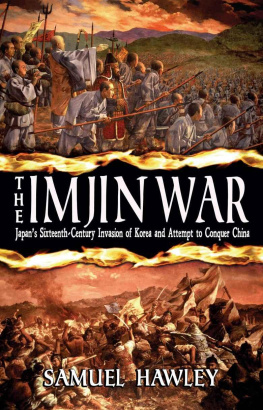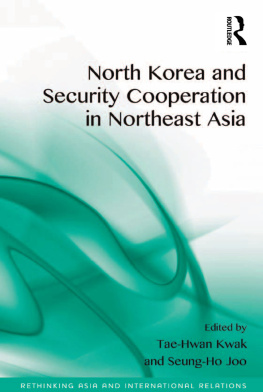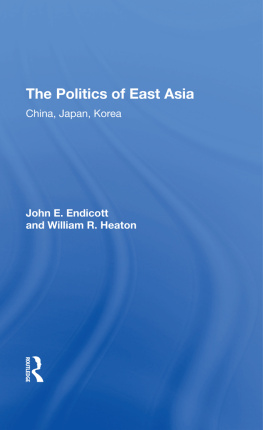THE IMJIN WAR
Japans Sixteenth-Century Invasion of Kore a and Attempt to Conquer China
by
SAMUEL HAWLEY
THE IMJIN WAR:
JAPANS SIXTEENTH-CENTURY INVASIO N OF KOREA AND ATTEMPT TO CONQUER CHINA
Second Edition
Copyright 2014 by Samuel Hawley
Published by Conquistador Press, 2014
ISBN (for eBook edition): 978-0-9920786-4-5
ISBN: (for print edition): 978-0-9920786-2-1
All rights reserved. No part of this publication may be reproduced, stored in a retrieval system, or transmitted in any form or by any means, electronic, mechanical, photocopying, recording or otherwise, without the prior written permission of the author.
The first edition of THE IMJIN WAR was published in 2005 by the Royal Asiatic Society, Korea Branch, Seoul and the Institute of East Asian Studies, University of California, Berkeley, with a second printing in 2008.
Conquistador Press
www.conquistadorpress.com
Visit the author at:
www.samuelhawley.com
ALSO BY SAMUEL HAWLEY
NONFICTION
I Just Ran:
Percy Williams, Worlds Fastest Human
Speed Duel:
The Inside Story of the Land Speed Record in the Sixties
Americas Man in Korea:
The Private Letters of George C. Foulk, 1884-1887
Inside the Hermit Kingdom:
The 1884 Korea Travel Diary of George Clayton Foulk
FICTION
Bad Elephant Far Stream
Homeowner With a Gun
Warfare is the greatest affair of the state,
the Tao of survival or extinction.
Tai Kungs Six Secret Teachings
4th century B.C.
CONTENTS
MAPS AND TABLES
PREFACE TO THE NEW EDITION
It will soon be ten years since The Imjin War was co-published in October 2005 by the Royal Asiatic Society in Korea and the Institute of East Asian Studies at UC Berkeley. My foremost thanks then, and now, is to Kim Kyong-mee for the many hours she spent with me, twice a week over the course of two years, translating the various Korean-language sources that were used in the preparation of this book. I would also like to renew my thanks to Kim Young-duk and Bae Sue-ja, respectively the president and general manager of the RASKB at the time The Imjin War was originally published; to IEAS managing editor Joanne Sandstrom for her copyediting skills; and to the So-ae Memorial Foundation and Poongsan Corporation, without whose support this book would never have been published in the first place.
The Imjin War book received virtually no marketing when it was first released and distribution was confined to just a few sources. Normally such lack of publicity and availability would doom a book to wither and die, unknown and unsold. But for some reason The Imjin War didnt wither. Readers found it, word got around and the initial print run of 2,000 copies eventually sold out. In 2008 a second printing was made.
As an older and wiser author today, more aware of the harsh realities of the book business, I look back on this modest success with a measure of wonder. When I set out to find a publisher in 2003, after four years of solitary research and writing, I contacted a number of literary agents and publishing houses, pitching it as a popular history for general readers, and I sat back expecting to receive at least a few favorable replies. Fifty-seven rejection letters followed, each assuring me that a book on a presumably obscure sixteen-century war in Korea wouldnt sell. To all the people who bought The Imjin War anyway when it finally came out, despite this conventional wisdom that they werent supposed to; to everyone who devoted the hours required to read through its many pages; to everyone who has said or written kind things about it over the years and encouraged me to write moreto all these people I would like to say: Thank you.
This new edition of The Imjin War is largely identical to the original version. The main difference is that I have eliminated the center section of pictures, replaced the Acknowledgements with this new Preface and designed a new cover. Everything else, including the text, is the same. I remain very proud of this book. It was a labor of love that required more time and drive and energy than I could ever muster again, and so I have decided to let it stand as I originally wrote it.
It has grieved me over the years to receive emails from people saying that they wanted a copy of The Imjin War but couldnt find one to buy, or that the only copy they could locate was being sold for an outrageously high price. It is my hope that these more reasonably priced paperback and eBook editions, coupled with easier availability and more widespread distribution, will overcome these problems.
Samuel Hawley
Kingston , Ontario, Canada
September 2014
INTRODUCTION
On December 8, 1941December 7 on the American side of the international date linearmy and navy forces of Japan launched a surprise attack on Western colonial possessions in Asia and the Pacific, initiating what would come to be known in Tokyo as the Great Pacific War. It was the final, ultimately disastrous step in an expansionist phase in Japanese history that had already led that nation into three other wars of increasing ambition: the Sino-Japanese War of 189495, the Russo-Japanese War of 190405, and the campaign to conquer China begun in 1931. By the summer of 1942, eight months into the Great Pacific War, the empire of Japan extended from Manchuria to Burma on the Asian mainland and south across the Pacific as far as the islands of Java and New Guinea. Then, in the face of overwhelming American power, it began to fall apart.
Today, this fifty-year period of international aggression tends to be regarded as an aberration in Japans long history, the only time most people are aware of when the Land of the Rising Sun dispatched armies overseas to conquer foreign lands. This, however, is not the case. The Sino-Japanese War, the Russo-Japanese War, the invasion of China, the Great Pacific Warthey all had an important antecedent that is little known in the West. In May of 1592, some 350 years before the attack on Pearl Harbor, the state of Japan, recently unified under a dictator named Toyotomi Hideyoshi, sent a huge army across the strait from Kyushu to Pusan on Koreas southern tip. Its objective was first to invade that neighboring kingdom, then to press on to Beijing and conquer China. Once China was securely in Hideyoshis grasp, he planned to extend his hegemony even farther: south into Vietnam, Cambodia, Thailand, and Burma; offshore to Sumatra, Java, Taiwan, the Ryukyu Islands, and the Spanish colony of the Philippines; west to Indiaperhaps even all the way to that distant place where the strange bearded men came from who had first appeared in Japan fifty years before, the southwestern barbarians who claimed to be from a country called Poru-tu-gal .
Hideyoshi, in short, was intent on conquering the whole world as it was then known to him, an ambitious goal for what was in fact the first centrally directed war of overseas aggression in the history of Japan.
The resulting conflict immersed Japan, Korea, and China, plus token forces from as far away as Thailand, in nearly seven years of bloody war. It came to be known to the Japanese under a variety of appellations, from the prosaic Korean War to the more poetic Pottery War and War of Celadon and Metal Type, references to the spoils that Hideyoshis armies took back with them to Japan. The Chinese would refer to it simply as the Korean Campaign, a designation lumping it together with two other military campaigns that occupied the armies of China in the 1590s, despite the fact that it dwarfed the other two in size. To the Koreans, who suffered by far the greatest devastation and loss, it would come to be known as Imjin waeran , the bandit invasion of the year imjin (water dragon), commonly rendered in English as the Imjin War.











